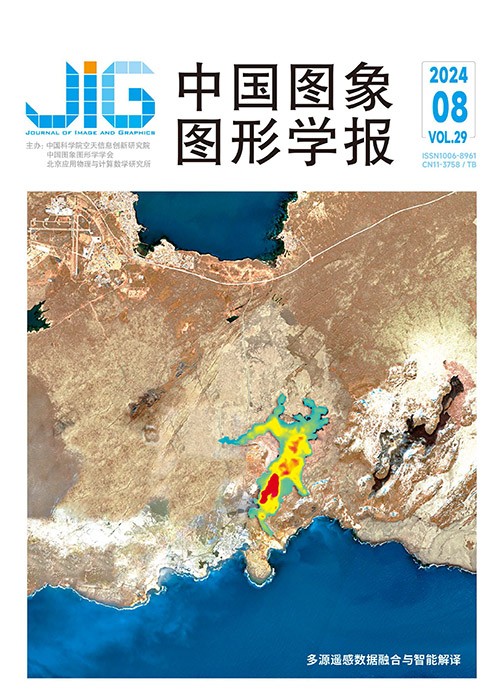
热红外高光谱遥感影像信息提取方法综述
摘 要
热红外高光谱遥感影像蕴含着丰富的光谱特性和温度信息,能够反映出地物、气体等特有的诊断特征,在矿物识别、环境监测和军事等众多领域发挥着重要作用。然而,由于热红外高光谱观测数据受到地表温度和发射率、大气环境和仪器测量噪声等共同影响,引起背景噪声与目标信号差异较小、耦合信号无法精确分离等问题,使得热红外高光谱影像信息提取存在巨大的挑战,难以有效实施应用。针对热红外高光谱信息提取的研究进展和现存难点,本文系统梳理了热红外高光谱影像信息提取方法,主要包括地表温度和发射率地表参量反演、热红外高光谱混合光谱分解、影像分类及目标探测。在此基础上,总结现有热红外高光谱信息提取的现状和问题,包括高光谱丰富光谱信息在地气参数反演方面尚未得到充分的利用,基于深度学习理论实现热红外高光谱地表参量反演及混合像元分解、地物分类、目标探测应用仍处于起步阶段且面临数据集匮乏。如何充分利用热红外高光谱密集通道,融合物理模型和深度学习理论实现智能化、高精度的地气参数一体化反演,并在此基础上进行热红外高光谱混合像元分解、地物分类、目标探测是热红外高光谱遥感影像信息提取未来可能的发展趋势和研究方向。
关键词
Review of information extraction methods from thermal infrared hyperspectral remote sensing images
Cao Liqin1, Wang Du2, Xiong Haiyang2, Zhong Yanfei2(1.School of Resource and Environmental Sciences, Wuhan University, Wuhan 430079, China;2.State Key Laboratory of Information Engineering in Surveying, Mapping and Remote Sensing, Wuhan University, Wuhan 430079, China) Abstract
Longwave infrared (LWIR) hyperspectral remote sensing images offer a wealth of spectral information alongside land surface temperature (LST) data, which make them invaluable for discerning solid-phase materials and gases. This capability holds significant implications across diverse domains, including mineral identification, environmental monitoring, and military applications. However, the underlying phenomenology and environmental interactions of emissive regions within the LWIR spectrum significantly diverge from those observed in reflective regions. This divergence impacts various facets of thermal infrared (IR) hyperspectral image (HSI) analysis, which span from sensor design considerations to data exploitation methodologies. Compounding this complexity are the intertwined influences of factors such as LST, emissivity, atmospheric profiles, and instrumental noise, which lead to challenges such as subtle distinctions between background noise and target signals, as well as inaccuracies in signal separation within thermal IR hyperspectral observation data. Consequently, the effective extraction of thermal IR HSI information poses formidable challenges for practical application implementation. In this study, we systematically review methods for LWIR HSI information extraction by drawing upon ongoing research progress and addressing prevailing challenges in LIWR hyperspectral remote sensing. Our examination encompasses four primary areas: 1) LST and emissivity inversion: LWIR hyperspectral remote sensing serves as a potent tool for large-scale LST and land surface emissivity (LSE) monitoring. However, the accurate retrieval of LST and LSE is fraught with complexity owing to their intricate coupling with atmospheric components, as delineated by the radiative transfer equation. We discuss two broad approaches, namely, the two-step method and the integration method, for mitigating this ill-posed problem. The former entails atmospheric compensation (AC) and temperature and emissivity separation (TES), where AC filters out atmospheric influences to isolate ground-leaving radiance from at-sensor radiance. Subsequently, TES methods are employed to estimate LST and LSE. Given the propensity for inaccurate AC to introduce accumulation errors and compromise retrieval accuracy, integration methods capable of simultaneous AC and TES are also reviewed, with deep learning-driven methods exemplifying a typical integration approach. 2) LWIR hyperspectral mixed spectral decomposition: spectral mixture analysis (SMA) involves identifying and extracting endmember spectra in a scene to determine the abundance of each endmember within each pixel. Most applications of LWIR SMA focus on mineral detection and classification. Unlike the reflectance of a mixed pixel, which is defined as a linear combination within the pixel, the emissivity of a mixed pixel is not as straightforward to define because the measured radiance depends on the emissivity and temperature of each material. The mixed spectral decomposition methods for isothermal and non-isothermal pixels are discussed. When a pixel is isothermal, the isothermal mixture model is identical to the mixture for reflectance after removing the temperature component. However, as a pixel becomes non-isothermal, unmixing methods are necessary to handle the nonlinearity resulting from temperature variations. This study summarizes all the methods and highlights the challenges associated with SMA. 3) Classification: classification tasks in the LWIR domain involve successfully modeling and classifying background materials, such as minerals and vegetation mapping. However, the scarcity of prominent spectral features in the LWIR spectrum complicates the remote differentiation of natural land surfaces. For instance, various materials such as paints, water, soil, road surfaces, and vegetation exhibit spectral emissivities ranging between 0.8 and 0.95. Moreover, although spectral emissivity variations exist among different materials, they are less conspicuous compared with the reflective region. In addition, the uncertainty associated with retrieved emissivity challenges the classification of different materials. This study reviews traditional machine learning classification methods, including spectral-based, spatial-based, and spectral-spatial integration-based methods, alongside deep learning approaches, by summarizing the advancements in these processing methods. 4) Target detection: target detection encompasses solid- and gas-phase targets. The algorithms employed for LWIR HSI analysis, which is similar to those used for visible-near IR and shortwave IR HIS, have reached a mature stage and are reviewed in this work, including matched filter-type algorithms, among others. Challenges in target detection mirror those encountered in classification tasks, given that spectral emissivities in the LWIR tend to be smaller than the corresponding spectral reflectance variations observed in the reflective region. Consequently, the performance of solid-phase target detection algorithms in real-world applications is impacted, particularly by their sensitivity to target-background model mismatch arising from similar emissivities and other errors. By contrast, gas detection in the LWIR domain relies on selective absorption and emission phenomena, particularly by chemical vapors, which exhibit narrow spectral features. Although gas plumes may span a large number of pixels, their detection depends on factors such as concentration, signature strength, and temperature contrast with the background materials. Consequently, chemical detection applications necessitate rigorous physical processes in airborne (down-looking) and standoff (side-looking) configurations. In addition to employing strict physical and statistical models, gas detection methodologies are increasingly integrating deep learning models. This trend reflects the recognition of the potential of deep learning in enhancing the capabilities of gas detection algorithms. Our discourse concludes with a discussion on the future trajectory and research direction of extracting information from thermal IR hyperspectral remote sensing images. Despite the continual integration of new technical methodologies such as deep learning, the computational intricacies inherent in LWIR hyperspectral remote sensing underscore the necessity of approaches that combine physical mechanisms with machine learning models. These hybrid methodologies hold promise in addressing the multifaceted challenges associated with LWIR HSI analysis, which paves the way for enhanced information extraction and practical application implementations.
Keywords
infrared hyperspectral land surface parameter retrieval spectral unmixing classification target detection
|



 中国图象图形学报 │ 京ICP备05080539号-4 │ 本系统由
中国图象图形学报 │ 京ICP备05080539号-4 │ 本系统由